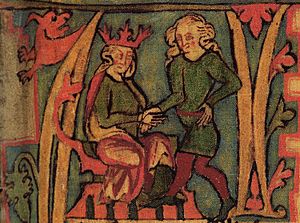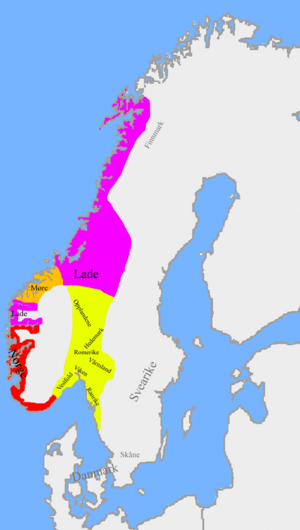Harald Fairhair facts for kids
Quick facts for kids Harald Fairhair |
|||||
|---|---|---|---|---|---|

Harald Fairhair (left) in an illustration from the fourteenth-century Flateyjarbók.
|
|||||
| King of Norway | |||||
| Reign | putatively 872–930 | ||||
| Successor | Eric Bloodaxe | ||||
| Born | putatively c. 850 Rogaland or Vestfold |
||||
| Died | putatively c. 932 Rogaland, Norway |
||||
| Burial | Haraldshaugen in Haugesund | ||||
| Spouse | Ragnhild the Mighty Åsa Håkonsdotter Snjófríthr/Snæfrithr Svásadottir |
||||
| Issue more |
Eric Bloodaxe Haakon the Good |
||||
|
|||||
| Dynasty | Fairhair | ||||
| Father | Halfdan the Black | ||||
| Mother | Ragnhild Sigurdsdotter | ||||
| Religion | Norse Paganism | ||||
Harald Fairhair (c. 850 – c. 932) was a famous Norwegian king. Many people believe he was the first king to unite Norway into one kingdom. This happened around 872 AD. Stories say he ruled until 930 AD.
After Harald died, two of his sons, Eric Bloodaxe and Haakon the Good, became kings. They continued his family's rule.
Most of what we know about Harald comes from old stories called sagas. These sagas were written down about 300 years after he lived. So, some parts of his life are not completely certain. However, these stories agree that Harald brought Norway together.
Since the 1800s, Harald has been seen as a national hero in Norway. He is a symbol of Norway's independence. Even though historians have looked closely at the old sagas, Harald is still known as the "father of the Norwegian nation." Some historians today even question if he existed exactly as the sagas describe.
Contents
What "Fairhair" Means
Harald's nickname, hárfagri, means "fair-haired" or "beautiful-haired." The word fagr means 'fair,' 'fine,' or 'beautiful.' It doesn't mean 'blond' like "fair-haired" often does in English.
Before he was called "Fairhair," some sources say Harald had another nickname: Lúfa. This meant 'thick, matted hair.' He got the "Fairhair" name after he finally cut his hair.
Was Harald Fairhair Real?
For a long time, historians believed the stories about Harald Fairhair from the sagas. But in the late 1900s, some historians started to wonder if he was real. Or if he was, did he really do all the things the sagas say?
Here are some reasons why some historians have doubts:
- No early records: There are no records from Harald's own time that mention him. The first king of Norway mentioned in records from that period is Harald Bluetooth. He lived later, around 985 AD.
- Sagas are later: The oldest written saga about Harald is from the early 1100s. This is more than 250 years after he supposedly died.
- Poems are unclear: There are two old poems that might be about Harald. They mention a king named Harald and some battles. But they don't always match the saga stories. Also, one poem calls him "Haraldr Hálfdanarson," not "Fairhair."
- Other Haralds: Some old British records mention a Norwegian king named Harald "Harfagera." But these records are talking about a different king, Harald Hardrada, who lived much later (died 1066 AD).
Historians today have two main ideas about Harald's existence:
- Origin Myth: Some think the story of Harald Fairhair is a kind of origin myth. This means it's a story created later to explain why Iceland was settled. It might also have helped later Norwegian kings claim their right to rule.
- Real King, Bigger Legend: A more common idea is that Harald Fairhair was a real king. He might have ruled a smaller part of western Norway. Over time, the stories about him grew and became bigger. This turned him into the legendary figure who united all of Norway.
Historians who believe the old poems are real often accept that Harald existed. But they are careful about trusting everything in the sagas.
Old Stories About Harald
Harald is mentioned in many old sagas. Some of these sagas even quote older poems. If these poems are truly from Harald's time, they are the earliest mentions of him.
Hrafnsmál
This old poem is believed to be from the 800s. It's a conversation between a valkyrie (a female warrior spirit) and a raven. They talk about Harald's life and battles. The poem describes Harald as an Yngling (a royal family). It calls him Lúfa (matted hair), not hárfagri. The poem also mentions a big battle at Hafrsfjord.
Glymdrápa
This is another praise poem about Harald. It's also from the late 800s. It talks about many battles Harald won.
Íslendingabók
This is one of the earliest written stories about Harald, from the 1100s. It says that Iceland was settled during Harald's time. It suggests that people left Norway to escape Harald's rule and his new taxes. This story is the first non-poem source to call him hárfagri.
Heimskringla
Written around 1230, this saga gives the most detailed story of Harald's life. It says Harald inherited several small kingdoms from his father, Halfdan the Black.
The saga tells a romantic story about how Harald decided to unite Norway. He wanted to marry a princess named Gyda Eiriksdottir. But she refused, saying she would only marry him if he was king of all Norway. Harald then made a promise not to cut or comb his hair until he achieved this goal. Because of this, he was called "Shockhead" or "Tanglehair" (Haraldr lúfa). Ten years later, after he had united Norway, he finally cut his hair. Then he became known as "Fairhair."
In 866, Harald began conquering the many small kingdoms in Norway. He won a great victory at the Battle of Hafrsfjord in 872. After this, he was king of the whole country. However, many of his enemies fled Norway. They went to places like Iceland, the Orkney Islands, and the Shetland Islands. Harald later had to go on expeditions to these islands to deal with the Vikings hiding there.
The saga also describes Harald's many sons. When he got old, he gave power to his favorite son, Eric Bloodaxe. Eric ruled alongside his father for a few years. Harald died around 933 AD from old age.
Egil's Saga
This saga, from the 1200s, tells a similar story to Heimskringla. But it shows Harald and his family in a more negative way. It also mentions Harald's promise not to cut his hair. The saga describes how Harald conquered different parts of Norway. It says that after his conquests, people in Norway faced heavy taxes and harsh rule. Many people chose to flee the country rather than stay.
Later Life and Burial

According to the sagas, Harald had many sons, possibly between 11 and 20. He gave them royal titles and lands to govern. But this didn't stop them from fighting among themselves.
When Harald became old, he passed his power to his favorite son, Eric Bloodaxe. Eric ruled with his father when Harald was 80 years old. This was likely a way for Harald to make sure Eric would be his successor. Harald died three years later.
Harald Fairhair is believed to be buried in a mound at Haugar, near the town of Haugesund. This area was a traditional burial site for early Norwegian rulers. In 1872, the Haraldshaugen monument was built there. It celebrates the Battle of Hafrsfjord, which is traditionally dated to 872.
Harald's Children
The sagas list many sons for Harald. However, an old poem called Hákonarmál mentions that Harald's son Håkon would meet "eight brothers" in Valhalla. This suggests the exact number of his sons is not fully known.
Here are some of his sons whose names appear in old poems:
- Eric Bloodaxe (whose mother was Ragnhild Eiriksdotter from Denmark)
- Håkon the Good (whose mother was Tora Mosterstong from Norway)
- Ragnvald
- Bjørn (possibly Bjørn Farmann)
- Halvdan (possibly two sons with this name)
Children According to Heimskringla
Snorri Sturluson's Heimskringla lists many of Harald's children:
- With Åsa, daughter of Håkon Grjotgardssson:
* Guttorm Haraldsson * Halvdan Kvite Haraldsson * Halvdan Svarte Haraldsson * Sigrød Haraldsson
- With Gyda Eiriksdottir:
* Ålov Årbot Haraldsdotter * Rørek Haraldsson * Sigtrygg Haraldsson * Frode Haraldsson * Torgils Haraldsson
- With Svanhild, daughter of Øystein Jarl:
* Bjørn Farmann Haraldssøon * Olaf Haraldsson Geirstadalf * Ragnar Rykkel Haraldsson
- With Åshild, daughter of Ring Dagsson:
* Ring Haraldsson * Dag Haraldsson * Gudrød Skirja Haraldsdotter * Ingegjerd Haraldsdotter
- With Snæfrithr Svásadottir, daughter of Svåse the Finn:
* Halfdan Long-Leg (who was killed by Torf-Einarr) * Gudrød Ljome Haraldsson * Ragnvald Rettilbeine Haraldsson (who was killed by Eric Bloodaxe on Harald's orders) * Sigurd Rise Haraldsson
- Other children:
* Ingebjørg Haraldsdotter
See also
 In Spanish: Harald I de Noruega para niños
In Spanish: Harald I de Noruega para niños
- Unification of Norway

